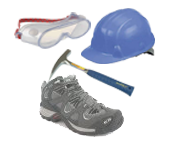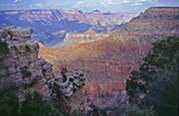Metamorphic Rocks
They are rocks that have "morphed" into another kind of rock. These rocks were once igneous or sedimentary rocks. How do sedimentary and igneous rocks change? The rocks are under tons and tons of pressure, which fosters heat build-up, and this causes them to change. If you exam metamorphic rock samples closely, you'll discover how flattened some of the grains in the rock are.
 A field term applied to any compact, dark-green, altered or metamorphosed basic igneous rock (e.g. spilite, basalt, gabbro, diabase) that owes its colour to the presence of chlorite, actinolite, or epidote.
A field term applied to any compact, dark-green, altered or metamorphosed basic igneous rock (e.g. spilite, basalt, gabbro, diabase) that owes its colour to the presence of chlorite, actinolite, or epidote.
![]() It is a fine-grained non-foliated metamorphic rock with no specific composition. It is produced by contact metamorphism. Hornfels is a rock that was "baked" while near a heat source such as a magma chamber, sill or dike. Mosaic structure of the mineral grains of nearly equal dimensions are characteristic. Depending on the distance from the pluton and on the mineralogical composition of the source rock that underwent contact metamorphosis, mineral associations and size as well as geochemical contents of hornfels are very variable.
It is a fine-grained non-foliated metamorphic rock with no specific composition. It is produced by contact metamorphism. Hornfels is a rock that was "baked" while near a heat source such as a magma chamber, sill or dike. Mosaic structure of the mineral grains of nearly equal dimensions are characteristic. Depending on the distance from the pluton and on the mineralogical composition of the source rock that underwent contact metamorphosis, mineral associations and size as well as geochemical contents of hornfels are very variable.
 It is a non-foliated metamorphic rock composed of recrystallized carbonate minerals, most commonly calcite ordolomite. Marble is a rock resulting from metamorphism of sedimentary carbonate rocks, most commonly limestone or dolomite rock. Metamorphism causes variable recrystallization of the original carbonate mineral grains. Marble is commonly used for sculpture and as a building material.
It is a non-foliated metamorphic rock composed of recrystallized carbonate minerals, most commonly calcite ordolomite. Marble is a rock resulting from metamorphism of sedimentary carbonate rocks, most commonly limestone or dolomite rock. Metamorphism causes variable recrystallization of the original carbonate mineral grains. Marble is commonly used for sculpture and as a building material.
 They are dense, hard rocks, generally uniform in texture, composed of fused quartz sand grains. Often the rock has a granular appearance on a weathered surface, but along a broken surface the sand grains are usually split. Also, unlike most of the nondescript rocks, quartzite has a glassy lustre.
They are dense, hard rocks, generally uniform in texture, composed of fused quartz sand grains. Often the rock has a granular appearance on a weathered surface, but along a broken surface the sand grains are usually split. Also, unlike most of the nondescript rocks, quartzite has a glassy lustre.
![]() It is a medium-grade metamorphic rock with medium to large grains of mica flakes in a preferred orientation. The individual mineral grains in schist, drawn out into flaky scales by heat and pressure, can be seen by the naked eye. Schists are typically associated with major mountain building events when shales or clay rich sandstones (wackes) are metamorphosed through depth of burial, and proximity to batholiths. The one I have in a Mica Schit.
It is a medium-grade metamorphic rock with medium to large grains of mica flakes in a preferred orientation. The individual mineral grains in schist, drawn out into flaky scales by heat and pressure, can be seen by the naked eye. Schists are typically associated with major mountain building events when shales or clay rich sandstones (wackes) are metamorphosed through depth of burial, and proximity to batholiths. The one I have in a Mica Schit.
It is a fine-grained,foliated, homogeneous metamorphic rock derived from an original shale-type sedimentary rock composed of clay or volcanic ash through low-grade regional metamorphism. It is the finest grained foliated metamorphic rock.
![]() A Type of slate is called Chiastolite which is a form of andalusite occurring in the shape of long prisms within carbonaceous clay slates. Growth occurs in layers with carbon deposited along the crystal edges as diagonal cruciform shapes are formed. It is also known as cross-stone. It is formed by contact metamorphism of carbonaceous shale.
A Type of slate is called Chiastolite which is a form of andalusite occurring in the shape of long prisms within carbonaceous clay slates. Growth occurs in layers with carbon deposited along the crystal edges as diagonal cruciform shapes are formed. It is also known as cross-stone. It is formed by contact metamorphism of carbonaceous shale.

